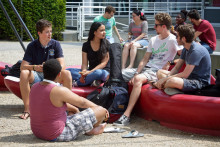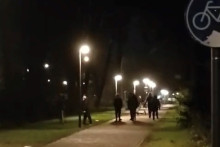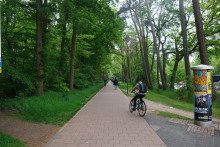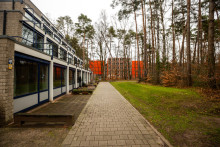‘The campus looks beautiful in spring […]. We think it’s important to see each other again in person, because that’s the best way to connect with each other. So let’s meet on campus!’
The most recent official Covid-19 mailing by the Executive Board reads like a passionate plea directed at students. The appeal did not come out of the blue; after all, there had been clear signs that students would not be readily returning to campus in this post-Covid-19-era, or inter-lockdown period.
‘All they know’
A number of programme directors have experienced this at first hand. Alma Schaafstal (Creative Technology and Interaction Technology, EEMCS faculty), Lisa Gommer (Mechanical Engineering and Sustainable Energy Technology, ET faculty) and Katja Haijkens (Biomedical Technology, Faculty of Science and Technology) say that it concerns a relatively small group of people who have fallen off the radar completely. ‘However, there is also a fairly large group that doesn’t attend the lectures, or does so only rarely,’ says Schaafstal. ‘It may well be as much as 50% of the students, depending on which lecturer you ask. So we’re dealing with a fairly substantial group that regularly avoids the campus and does not become part of the community. We simply don’t know them; and that definitely worries me. We’re out of lockdown, but it’s proving difficult to get the lockdown out of the students.’
According to Haijkens, it is mostly the second-year students who stay away from campus. ‘Which is not all that surprising; the previous academic year was almost entirely online for them. And there were a few lockdown periods in this academic year as well. It’s simply all they know.’ Gommer has observed a similar pattern and shares these concerns. ‘It’s proving extremely difficult to get a certain group of students to come back’, she says. ‘Some students prefer to have all lectures recorded so that they can follow them remotely or re-watch them in their own time.’
Mandatory lecture recording
Perhaps that is the most plausible reason why a relatively large number of students are staying away from campus. After all, all UT study programmes are still required to record all lectures, in case someone has to go into quarantine. ‘Yes, we’re still required to do that. And in some cases, it’s perfectly reasonable. But you can’t fool me into thinking that you’ve been in quarantine for five consecutive weeks – because we also see cases like that’, says Schaafstal.
Gommer is particularly concerned about the quality of hybrid teaching. ‘The recordings are usually not of the best quality – and from a didactic point of view, you could argue that a remote lecture with little interaction is not the best way to receive education.’ ‘Moreover’, Schaafstal adds, ‘we’ve also noticed that lecturers have difficulty with this form of teaching themselves. They can’t look students in the eye, because they’re at home, and they miss the interaction – especially when the rest of the group is physically present.’
Haijkens is also not in favour of hybrid teaching. ‘It may sound easy, but it’s extremely complicated to realise. Not just the technical side of it, but also the interaction between students and the lecturer. During a face-to-face lecture, it is much easier for the lecturer to pick up on signals of whether the group understands something or not. Now, they sometimes get the feeling that they’re teaching in front of an empty room when they have to record their lectures.’
‘I’m shocked by the recent lack of engagement’
A loss of quality?
To what extent does the hybrid teaching form actually undermine the quality of the education provided? According to the programme directors, this is difficult to determine. ‘But we have certain forms of teaching that do not lend themselves well to the hybrid form’, Schaafstal explains. ‘Take tutorials, for example. They depend heavily on peer-to-peer learning. Students consult with each other, compare their work with that of other groups, and are offered on-site support by lecturers or student assistants. These are all important aspects that you cannot achieve in an attic room.’
This also applies to a number of tutorials and practicals in Biomedical Technology, Haijkens points out. ‘In fact, it’s impossible to follow them online. Fortunately, many students understand this and at least attend the practicals in person.’ ‘There’s an important social aspect that underlies the quality of education’, Gommer adds, ‘namely, mutual interaction. For example, having a chat with the lecturer after the lecture has ended, so that you can continue to ask questions. Or talking to a fellow student on the way out of the lecture hall. Or dropping by the study association to ask for help from an older student, should you run into any problems.’
‘Shocked by the lack of engagement’
Therefore, the programme directors’ greatest concerns have to do with the students’ sense of community, their engagement and their development. ‘I’m shocked by the recent lack of engagement’, says Gommer. ‘The response to teaching evaluations and participation in panel discussions with lecturers have come to a complete standstill – either only a handful of students show up, or no one at all. Last week, I saw a lecturer in a meeting room sitting all alone, with a plate of sandwiches. That says it all.’ Haijkens shares that sentiment. ‘I also see it reflected in the lack of response to evaluations. It’s important to feel a sense of connection with a study programme. Studying, especially at academic level, is more than just attending lectures remotely. You’re part of an academic learning community.’
Schaafstal is particularly concerned about her students’ development. ‘At a certain point, after someone has left secondary school, you hope that they will show a sign of begeisterung. That students will say: this is my programme, this is what I’m good at, this is what I can and want to learn. I’m afraid that the decisive penny, the determining factor for someone’s future plans, is not going to drop online.’
‘Not compulsory’
How can the study programmes get students to come back to campus? The programme directors do not see any point in making it compulsory. ‘I know that some of the programme directors are thinking about it. They’re considering making the lectures compulsory, or at least putting more pressure on the students to force them to attend’, says Haijkens. ‘Personally, I’d find that odd. We’re trying to teach students to adopt an academic attitude towards their studies. They are responsible for their own lives and their own learning, so I don’t think compulsory education is appropriate.’ Gommer: ‘No, compulsory education seems crazy to me. But as long as we, as study programmes, are required to offer an online alternative, I’m afraid that it’ll simply be too convenient for students to stay away.’
'Some of them have no idea how beautiful the campus is, or how important it is for the sense of community and your well-being to meet up in person.'
Stamp card
Grace Iroagalachi, student assessor at the EEMCS Faculty Board, recently came up with a “Back to Campus” initiative to lure students back ‘in a positive way’. ‘I made loyalty cards. If students take these stamp cards to their study association and collect enough stamps, they can win some great prizes. In addition, students can exchange tokens for free drinks at their study association.’
According to Iroagalachi, the main goal of her initiative is to lower the threshold for students to come to campus. These past two years, many students have been unable to enjoy the university experience. Some of them have no idea how beautiful the campus is, or how important it is for the sense of community and your well-being to meet up in person. No student is the person they were before the pandemic. But one important change is that students now have a choice whether or not to attend lectures in person. The pandemic has forced us to change the way we look at education. It wouldn’t be very imaginative to just go back to the way things were before. We should try to hold on to the positive things. That also means that we should motivate students to come to come back to campus.’
Proving added value
Gommer also sees merit in a more positive approach. ‘We’re focusing on social events, like get-togethers and barbecues. We’re also setting up a sort of College Tour, but through interviews with our own professors.’ Schaafstal also thinks it is important to tempt students to come back. ‘We do that by proving that the face-to-face education we provide is better than the online alternative. We have to prove the added value in terms of content.’
Along the same lines, Haijkens thinks it would be a good idea to start talking to students (even more). ‘I’d like to get a better understanding of their motives. And, more importantly, what would motivate them to come to campus? Surely, they had a good reason for choosing this university, which offers education on campus? Otherwise, they might as well have taken a LOI course.’








